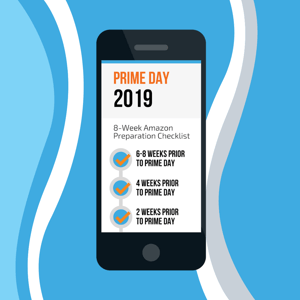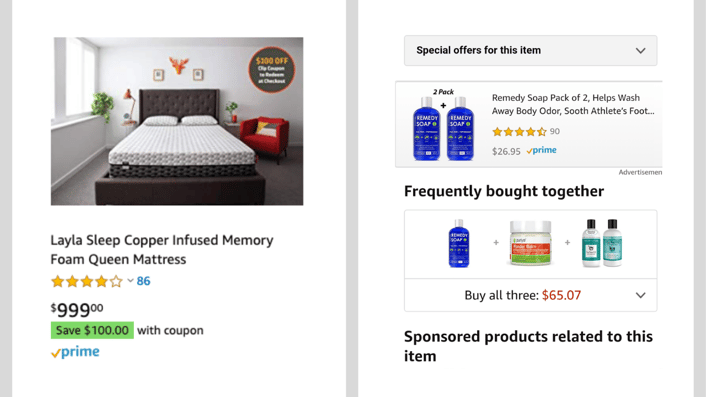By now, you’ve hopefully got your Prime Day 2019 strategy locked down.
But sometimes it’s useful to dig a little deeper, especially when the stakes are so high.
We thought it might be useful to shine a light on some less discussed aspects of how Prime Day plays out. Even if you only pick up something small, this could make a world of difference and give you an edge on the big day.
See below for our list of “4 Things You May Not Know About Prime Day”.

1) Conversion rates may decrease in the lead up to Prime Day
Prime Day 2018 spanned 36 hours and resulted in the biggest day of sales in Amazon’s history, despite a myriad of technical difficulties. Shoppers have come to expect amazing deals and Amazon does everything in their power to ensure that each Prime Day event is bigger than the last. Anticipation levels are high and this informs consumer behavior.
For example, many savvy shoppers are adding favorite items to their cart right now so it will be easy to identify the best bargains once the Prime Day deals go live. As a result, in the window before Prime Day, some brands may notice impressions and clicks increasing, and a reduced conversion percentage for both organic and paid traffic.
This should not be a major cause for concern. If anything, it may be a good sign that your products are in high demand and will be snapped up on Prime Day! However, if you find yourself in this position, there are a few steps you may want to consider taking:
- Adjust your current PPC campaigns. Paid advertising helps improve discoverability on Amazon. If the data suggests that consumers are adding your products to their cart in anticipation of Prime Day, you may want to reduce bids now on relevant campaigns to avoid wasted spend. This budget may be better re-allocated to the Prime Day period where visibility is everything.
- Re-think your Prime Day strategy. Customers adding your product to their cart is great, but getting them to pull the trigger is the ultimate goal. If customers don’t see a deal pop up during the Prime Day period they may opt to purchase a competing product instead. If there are no deals planned for popular products now is the time to act.
- Think carefully about inventory. A lot of clicks and impressions now could mean a huge number of conversions during Prime Day. The easiest way to let this great opportunity slip through your fingers is not preparing adequately from an inventory management perspective. Amazon recommends getting Prime Day inventory to fulfillment centers by June 27th. Also, having the ability to enable FBM (Fulfilled By Merchant) fulfillment with free shipping and 2-day delivery if FBA stock runs out during the Prime Day period could make a huge difference.

2) Vendors can still pull some levers
3P Sellers generally have more control of their Amazon presence compared to 1P Vendors. However, that doesn’t mean Vendors can’t take strategic steps to win big on Prime Day. We’ve outlined a few examples below.
- The main perk about being a Vendor during Prime Day is that you can create Lightning Deals on your own compared to the Seller Central model where Amazon needs to recommend and enable a Lightning Deal. Vendors should be analyzing inventory levels, profit margins and sales velocity across their Amazon catalog to create Lightning Deals that will resonate with Prime Day shoppers.
- There’s an additional option for Vendors when creating Lightning Deals - you can opt in to have Amazon evaluate your deal and consider placing POs at a reduced promotional cost. If margins allow for discounts, Vendors can get large POs this way. However, there is a risk of Amazon overstocking and then not ordering for quite some time. Therefore, Vendors always need to be careful with how much inventory they actually accept with such POs.
- When creating a price discount promotion in Vendor Central, Amazon may have the promo optionally merchandised by site merchandisers, the Amazon email team, and the Amazon Deals team, which can result in more traffic.
- When doing promo codes in Vendor Central, Vendors can opt in to share the promo code with Amazon Influencers and Associates. Opting in does not guarantee placement, however, it’s yet another way to gain more traffic if Amazon decides to share the promo.
Tip: submit your promos well in advance so Amazon can properly estimate inventory needs for upcoming POs.

3) Some promotions are more visible than others
It’s important to have a clear understanding of how different promotions actually appear to shoppers.
For example, Percentage Discount and BOGO offers are often only visible below the fold on the product display page and they lack the ultra visibility of Lightning Deals or Coupon offers (which show in organic search results as well). Therefore, certain promotions are a little harder for the average shopper to find.
Above: Comparison between a offer visible below the fold on the product
display page and a coupon showing prominently in search.
Ideally brands will have some historical data regarding which type of promotions work best on Prime Day, and how such promotions align with other critical factors such as profit margins for each SKU and inventory availability. If this is your first year experimenting with Prime Day deals, we would strongly recommend tracking the results of all promotions so you can use this data moving forward.
4) Brands can gather new customer metrics for the first time
In November 2018, Amazon launched a new group of metrics that, for the first time, provide information about customer loyalty.
This group of metrics is called “new-to-brand” (NTB) and is available to both Sellers and Vendors. These metrics are also available for demand-side platforms - DSP (for Amazon property websites, not for 3rd-party sites).
Many brands see Prime Day as a huge customer acquisition and/or consolidation opportunity. The NTB metrics will help brands get more clarity about how valuable their Prime Day marketing efforts truly are.
We recently published a comprehensive blog post on the NTB metrics, you can check it out here.
Conclusion
Some of the recommendations outlined above may not be possible to implement at this point in time for a variety of reasons e.g. deal submission deadline date has passed. However, the general optimization principles outlined will hold true for all high-traffic retail events on the Amazon platform such as Black Friday, Cyber Monday and Q4 in general.
If you’re still looking for more assistance, we’d recommend that you review our recent blog post How To Get Ready For Prime Day 2019 and download our Prime Day Checklist.

Get ready for Prime Day!
Get your 8 Week Amazon Prime Day preparation checklist with week by week tips before Prime Day!
Tagged: Seller & Vendor Central, Amazon Display Advertising, Operations
.png)


